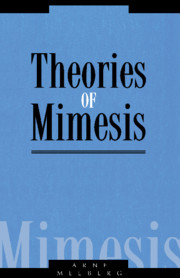Introduction, rehearsal and repetition
Published online by Cambridge University Press: 04 December 2009
Summary
Mimesis and repetition are the basic terms of this book, and its basic argument is that mimesis turns – somehow, at some time – into repetition.
This statement could be developed in at least two ways, which seem like two alternative ways of describing and analysing the phenomenon of mimesis:
The turning of mimesis into repetition is the result of a historical process that slowly invests mimesis with temporal dimensions. Modernity, which can be localized as starting in the eighteenth century, is here of decisive importance; the modern development of mimesis results paradoxically in its fulfillment and disappearance, meaning that similarity gives way to difference.
Mimesis is inherently and always already a repetition – meaning that mimesis is always the meeting-place of two opposing but connected ways of thinking, acting and making: similarity and difference.
In this book I am using the second way of thinking about and discussing mimesis, which implies that I am always inclined to find movements of difference even in those versions of mimesis that suggest similarity; and even in the oldest versions of Plato and Aristotle. I do not want to discard a historical approach, however, and I am actually using one, in the simplest way possible, by arranging my four studies chronologically and not wanting to exclude a historical development between them. That means, however, that I have avoided the question of the historicity of the concept: the problems involved seemed overwhelming.
- Type
- Chapter
- Information
- Theories of Mimesis , pp. 1 - 9Publisher: Cambridge University PressPrint publication year: 1995



